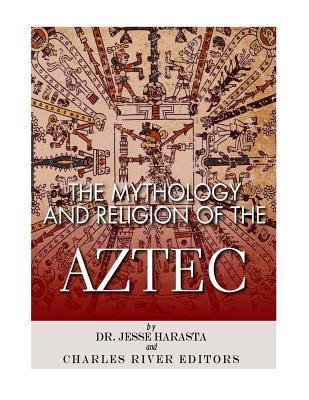The Mythology and Religion of the Aztec

The Mythology and Religion of the Aztec
*Includes Spanish accounts of the Aztec's human sacrifices
*Includes footnotes and a bibliography for further reading
"They strike open the wretched Indian's chest with flint knives and hastily tear out the palpitating heart which, with the blood, they present to the idols...They cut off the arms, thighs and head, eating the arms and thighs at ceremonial banquets. The head they hang up on a beam, and the body is...given to the beasts of prey." - Bernal Diaz, a Spaniard who described the Aztec's human sacrifice From the moment Spanish conquistador Hernan Cortés first found and confronted them, the Aztecs have fascinated the world, and they continue to hold a unique place both culturally and in pop culture. Nearly 500 years after the Spanish conquered their mighty empire, the Aztecs are often remembered today for their major capital, Tenochtitlan, as well as being fierce conquerors of the Valley of Mexico who often engaged in human sacrifice rituals. Ironically, and unlike the Mayans, the Aztecs are not widely viewed or remembered with nuance, in part because their own leader burned extant Aztec writings and rewrote a mythologized history explaining his empire's dominance less than a century before the Spanish arrived. While the Mayans are remembered for their astronomy, numeral system, and calendar, the Aztecs have primarily been remembered in a far narrower way, despite continuing to be a source of pride to Mexicans through the centuries. As a result, even though the Aztecs continue to interest people across the world centuries after their demise, it has fallen on archaeologists and historians to try to determine the actual history, culture, and lives of the Aztecs from the beginning to the end, relying on excavations, primary accounts, and more. That said, more is known about Aztec religious practices than any other aspect of their culture, mostly because the major element in the public ceremonies was focused on human sacrifice. The rituals were apparently so gruesome that they horrified even the Spanish, who were not exactly known for their gentility when it came to war and religious fervor. A Spaniard named Bernal Diaz described what happened at one religious ceremony: "They have a most horrid and abominable custom which truly ought to be punished and which until now we have seen in no other part, and this is that, whenever they wish to ask something of the idols, in order that their plea may find more acceptance, they
PRP: 63.09 Lei
Acesta este Prețul Recomandat de Producător. Prețul de vânzare al produsului este afișat mai jos.
50.47Lei
50.47Lei
63.09 LeiIndisponibil
Descrierea produsului
*Includes Spanish accounts of the Aztec's human sacrifices
*Includes footnotes and a bibliography for further reading
"They strike open the wretched Indian's chest with flint knives and hastily tear out the palpitating heart which, with the blood, they present to the idols...They cut off the arms, thighs and head, eating the arms and thighs at ceremonial banquets. The head they hang up on a beam, and the body is...given to the beasts of prey." - Bernal Diaz, a Spaniard who described the Aztec's human sacrifice From the moment Spanish conquistador Hernan Cortés first found and confronted them, the Aztecs have fascinated the world, and they continue to hold a unique place both culturally and in pop culture. Nearly 500 years after the Spanish conquered their mighty empire, the Aztecs are often remembered today for their major capital, Tenochtitlan, as well as being fierce conquerors of the Valley of Mexico who often engaged in human sacrifice rituals. Ironically, and unlike the Mayans, the Aztecs are not widely viewed or remembered with nuance, in part because their own leader burned extant Aztec writings and rewrote a mythologized history explaining his empire's dominance less than a century before the Spanish arrived. While the Mayans are remembered for their astronomy, numeral system, and calendar, the Aztecs have primarily been remembered in a far narrower way, despite continuing to be a source of pride to Mexicans through the centuries. As a result, even though the Aztecs continue to interest people across the world centuries after their demise, it has fallen on archaeologists and historians to try to determine the actual history, culture, and lives of the Aztecs from the beginning to the end, relying on excavations, primary accounts, and more. That said, more is known about Aztec religious practices than any other aspect of their culture, mostly because the major element in the public ceremonies was focused on human sacrifice. The rituals were apparently so gruesome that they horrified even the Spanish, who were not exactly known for their gentility when it came to war and religious fervor. A Spaniard named Bernal Diaz described what happened at one religious ceremony: "They have a most horrid and abominable custom which truly ought to be punished and which until now we have seen in no other part, and this is that, whenever they wish to ask something of the idols, in order that their plea may find more acceptance, they
Detaliile produsului









